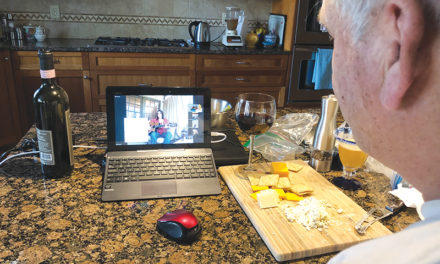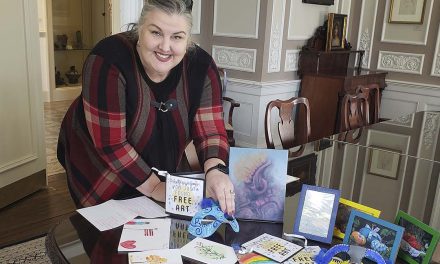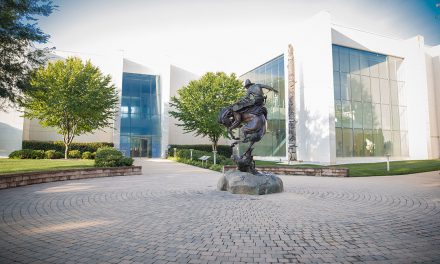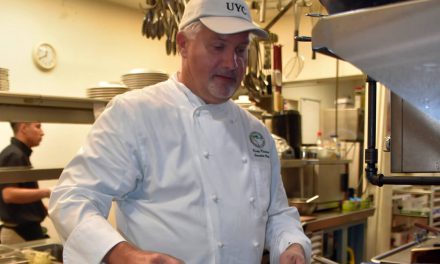Images from Antarctica
In January, Lakeside Senior reporter Pam Keene and her husband Rick Fulgham journeyed to the bottom of the planet for a two-week adventure to Antarctica. It started with three days in Buenos Aires, then a 3-hour flight to the world’s southernmost city before they boarded a ship for an adventure of a lifetime.
Dateline: Buenos Aires. It’s hot here! After all, it’s summer in the southern hemisphere. Temperatures reached the high 80s and low 90s, making packing a challenge considering we would be headed to Antarctica in just a few days.
Buenos Aires was still basking in the glow of Argentina earning the FIFA World Cup. Giant photos, T-shirts emblazoned with Messi across them and Argentina blue-and-white flags flying everywhere reminded us that though we were near the bottom of the globe Argentinians were on top of the world – the sports world.
Our hotel was well-located near an active pedestrian area with shopping and restaurants. It was easy to walk or hail a cab to venture out. After a trip to the city’s famed Paseo Ed Rosedal Garden with more than 18,000 roses planted near a network of several lakes, we joined some of our new best friends – other travelers with similar interests – for dinner at an Italian restaurant three blocks from the hotel. The owner took good care of us – in fact such good care that we ate dinner there again.
The next day about 10 of us toured Teatro Colon, one of the most spectacular opera houses in the world. Again, it was within walking distance of our hotel and allowed us a leisurely walk and plenty of exploring on the way back. Our trip leader, Nelson, guided us to our Welcome Dinner and a chance to experience steak the way the Argentinians eat it – juicy and rare, complimented by Argentinian wines. An after-dinner walk along the Rio de la Plata where nightly festivities include music, dancing, people in costumes, including Spiderman, and vendors hawking their wares.
For our final day, the life and lore of Eva Peron took center stage. An actress who married Argentinian President Juan Domingo Peron. As a political activist, first lady and philanthropist from 1946-1952, she’s still a revered figure and her images grace buildings, stand as sculptures in parks and provide an example for the country. Although she died in 1952 at age 33, her legend and life are very much alive.
Too soon, it was time to head to the southernmost city in the world: Ushuaia, at the very tip of South America. It’s a charming port town, crowded with giant cruise ships, trekkers and people like us headed to the Shetland Islands and Antarctica. The elegant 300-foot Hebridean Sky, our home for the next 10 days, cut an impressive image against the harbor. It was one of the smaller vessels headed to Antarctica, with a capacity of around 90 passengers.
The journey begins
Leaving port we traveled the Beagle Channel, passing a colony of penguins and being followed by several marine birds, including albatross, petrels and terns. After several hours at sea, we entered the Drake Passage. Known as the world’s most treacherous waters, at first it was relatively calm. As our journey progressed, we’d find out if it would be the Drake Lake or give us a serious Drake Shake.
However, looks can be deceiving. In the dining room, the tables and chairs were chained to the floor. It was a preview of what was to come as some of us took our first doses of Dramamine or Bonine to prepare for rough seas. My gingersnaps and oyster crackers took their place on the bedside table.
What began as gentle rollers through the night turned into a mild Drake Shake as we headed toward the Shetland Islands, an archipelago near the continent and our first landfall. Then the winds built to as strong as 45 knots and the waves started reaching 35-40 feet as we made our 48-hour passage.
We met our expedition team, seven scientifically trained experts that would lead us on Zodiac excursions and land explorations to see the marvels of the continent. Each had a special area of expertise: whales, birds, geology, ecology, botany, weather and so forth. Throughout the trip, we’d have talks to compliment what we’d see that day.
The weather varied from bright, clear and sunny with minimal winds to snowy and gray or raining with strong winds. Temperatures ranged from 28 degrees to 38; the water temperature was a steady 28 degrees.
Icebergs floated on the ocean in interesting shapes created by the winds and waves. Tall snow-and ice-covered mountains were bright white, sometimes with black rock showing. There is no soil in Antarctica, so any plants – mostly mosses – grew on the rocky surfaces. Occasionally, a loud crashing sound followed by a huge splash could be heard as an icy cliff would break off into the sea. That’s called calving, and it creates many of the ice formations and patches of ice on the sea’s surface.
Shore excursions and wildlife
Our landings were determined by the weather and assessments by the team to ensure safety. Then we loaded into the zodiacs and headed ashore, where we were greeted by hundreds and hundreds of penguins who waddled or slid on their bellies to go from place to place. They’d stay on the snow and rocks, and sometimes take a swim that would turn their muddy bellies to pure white.
Our most memorable shore excursion took us to Port Lockroy, a still-active research station operated by the British. We met the newest volunteers, four women who would be living there for four months of the Antarctic summer. One of their jobs is managing the only post office on the continent, where about 70,000 postcards and other mail is sent by 18,000 visitors each year over the cruise season. It has a gift shop and a museum that represents how researchers in the 1940s and 1950s lived, including their kitchen, a darkroom and bunks.
Port Lockroy’s highlight was the very busy penguin rookery where many of the gentoo penguins guarded their nests as they waited for their eggs to hatch. Penguins mate for life and both the male and female share brooding duties. They “feather their nests” with small rocks, building up the sides to allow the penguin to sit atop the mound with the egg nestled between its legs.
We also visited Damoy Point, known as the world’s southernmost waiting room because it’s a small airfield where a red biplane fitted with skis lands and takes off carrying researchers, scientists and restoration crews to study the weather patterns, wind speeds and wildlife at other bases on the continent.
From humpback whales feeding to seals lounging on the snow, the wildlife in Antarctica is incredible. Dozens of species of birds: gentoo, Adelie and chinstrap penguins; several species of albatross, terns, skuas, sheathbills, gulls, cormorants and shearwaters took to the skies and nested on cliffs.
Sightings of leopard seals, elephant seals and Weddle seals were complemented by other mammals: three types of dolphins and an abundance of humpback whales that were usually almost too far away to photograph more than a glimpse of their backs or a flip of their flukes as they surfaced for a breath of air.
No one dared asked when we’d see polar bears because they’re native only to the Artic. Penguins rule in Antarctica. We didn’t want to show our ignorance!
Never-ending exploration
Since returning home, I’ve dived into books about the early Antarctic explorers, including Adrien de Gerlache who with his crew in 1897-99 was the first to winter on the continent; Robert Falcon Scott who explored the farthest south and also was the first to fly a balloon over the Antarctica; and Ernest Shackleton who bested Scott’s southernmost point and is best known for the 1907-09 exploration on “Endurance.”
Somehow, I can’t stop thinking about this trip, much more so than other recent journeys. As we move into spring and summer in the Northern Hemisphere, I think about what’s to come for Antarctica – gradually the nights grow longer as winter in the Southern Hemisphere approaches. The temperatures will drop to far below freezing and there will be many successive nights with no sun.
Although I can now say I’ve been there, it’s just the tip of the iceberg – pun intended – of what those early explorers experienced. Would I go again? What do you think?








